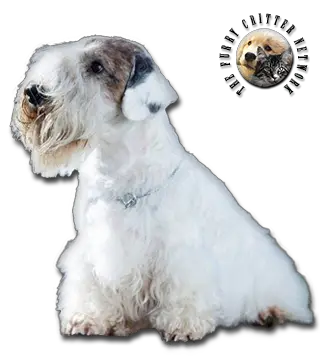Breed Standard
Head: Strong and elongated. Broad, slightly domed skull. Square, powerful jaws. Thick beard.
Ears: Medium size, hanging close to the cheeks.
Eyes: Medium size, round. Dark color. Dark rims are preferred.
Body: Longer than tall. Thick neck. Deep, broad chest is well let down. Ribs well sprung. Exceptionally powerful hindquarters.
Tail: Carried straight. Typically docked.
Hair: Long, hard, wiry. Weather-resistant undercoat.
Coat: All white, or white with lemon, chestnut, blue, or badger markings on the head and ears.
Size: Less than 31 cm (12,2 in).
Weight: Dog: 9 kg (19,9 lb).Bitch: 8 kg (17,7 lb).
History
The Sealyham was once one of the more popular terriers, and one of the best known Welsh breeds. Today, however, the Kennel Club (UK) lists the Sealyham as amongst the most endangered native breeds. In 2008, registrations of new puppies with the Kennel Club dropped to an all-time low of 43, placing it among the bottom three on the list of Vulnerable Native Breeds. In October 2011, British magazine Country Life highlighted the breed on its front cover, with the heading "SOS: Save our Sealyhams", and launched a campaign to save the breed. End of year figures for 2011 showed that 49 puppies were registered with the Kennel Club in the UK, keeping them within the bottom three on the list of most endangered breeds.
Another notable Sealyham Terrier, Ch. Efbe's Hidalgo At Goodspice, also known as Charmin, won Best In Show at Crufts in 2009, but his victory was not televised as the BBC had dropped the coverage of the competition earlier that year, following the controversy after the channel showed the documentary Pedigree Dogs Exposed. He had previous won the AKC/Eukanuba National Championship in the United States in 2007, and the World Dog Show in 2008. While in retirement, Charmin attended many shows as a spectator until he died in October, 2018.
Harry Parsons, founder of the Working Sealyham Terrier Club, has stated that, "To sustain a breed...you need between 300 to 500 puppies a year". The Kennel Club has blamed the decline of the breed on the availability of designer dogs and newer breeds such as the Shih Tzu, and the banning of tail docking which has reduced their ability as working dogs. Paul Keevil, formerly of the Kennel Club's vulnerable breeds committee explains: "Traditionally, soon after Sealyhams were born, their tails were docked by half their length, because they were small working dogs and they quite often got stuck down holes, meaning that they required short, strong tails for the owner to be able to pull them out." As of 2010, the breed is ranked 152nd out of 168 breeds according to registrations by the American Kennel Club. By 2017, the breed ranked 150 out of 190 breeds registered by the American Kennel Club.
Behavior
This robust, active, lively, bold, courageous dog is cheerful, calm, and stable. As a pet, the Sealyham Terrier is affectionate and gentle with children. Ever vigilant, he will bark a loud warning if a stranger comes near. Firm training is required.
The Sealyham Terrier can adapt to life as a house dog if he is exercised every day. Daily brushing and combing is required. Professional grooming is necessary.
Function
Hunting dog, Ratter, Pet.
Health
This is a hardy breed with few breed specific health problems. The main hereditary problem highlighted by the American Sealyham Terrier Club is an eye condition called lens luxation, for which there are DNA tests. Lens luxation is a condition in which the lens slips out of position in the eyeball due to the weakening of the fibers that hold it in place. This in turn blocks the flow of fluids in the eye, leading to a painful increase in intra-ocular pressure glaucoma and often irreparable optic nerve damage, leading to visual field loss and eventual blindness.
As of November 2011, the Kennel Club has not highlighted any specific concerns regarding the breed's health to conformation show judges. Due to the low numbers of the breed, two of the most prevalent problems facing the breed today is the popular sire effect and the general problem of genetic diversity within the breed.






